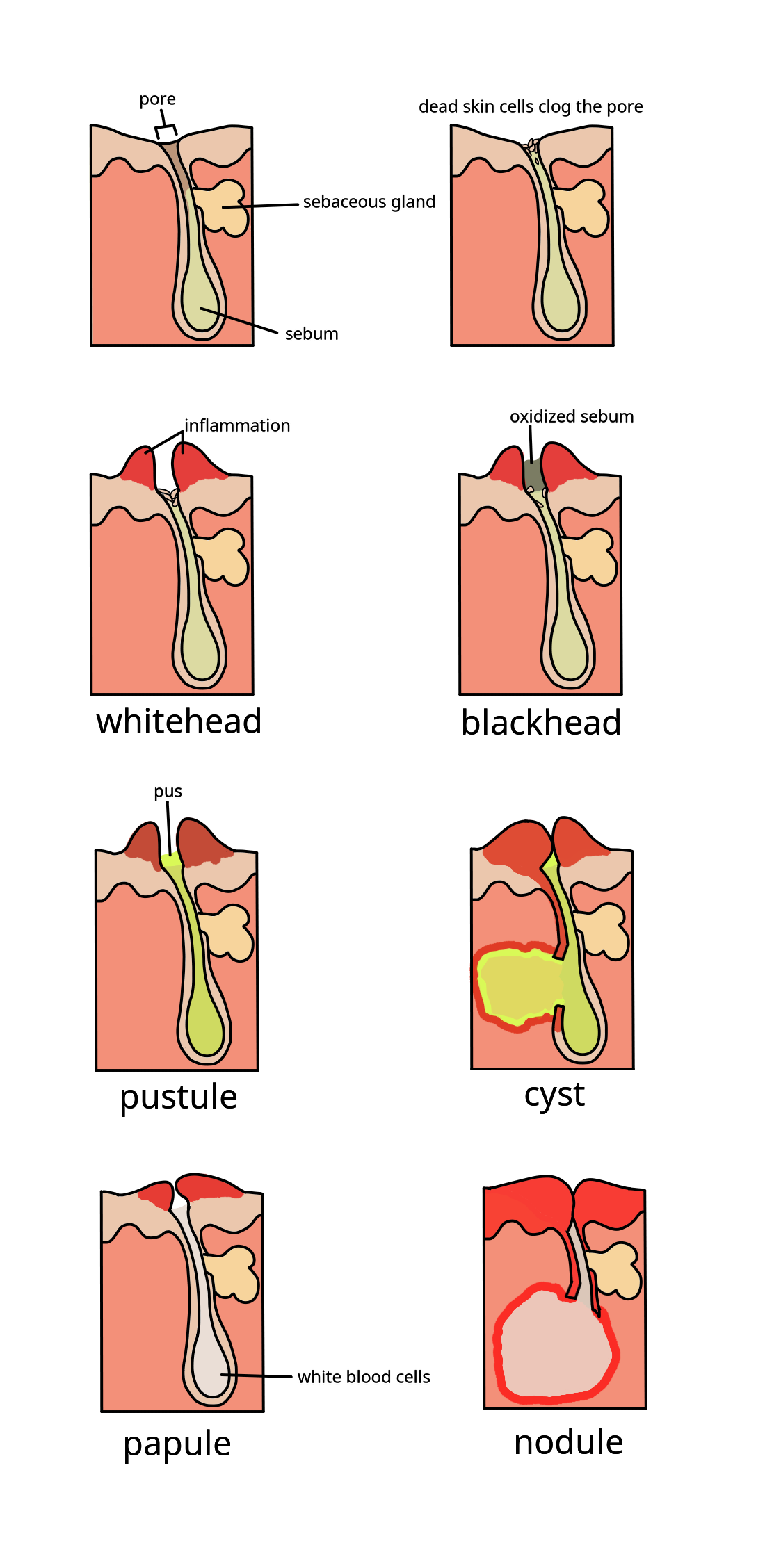|
Retinoids
The retinoids are a class of chemical compounds that are natural derivatives of vitamin A or are chemically related to it. Synthetic retinoids are utilized in cosmetic formulations, clinical dermatology, and the treatment of some forms of cancer. Retinoids have many important functions throughout the body, including in vision, regulation of skin proliferation and differentiation, growth of bone tissue, immune function, and male fertility. The biology of retinoids is complex, having well-documented effectiveness in the management of conditions ranging from acute promyelocytic leukemia to acne to photoaging. On the other hand, retinoids may be involved in metabolic dysfunction and, at least in some forms, carcinogenesis. Types Retinoids are divided into four generations based on their molecular structure and receptor selectivity. Structure The basic structure of the hydrophobic retinoid molecule consists of a cyclic end group, a polyene side chain and a polar end group. The c ... [...More Info...] [...Related Items...] OR: [Wikipedia] [Google] [Baidu] |
Tretinoin
Tretinoin, also known as all-''trans'' retinoic acid (ATRA), is a medication used for the treatment of acne and acute promyelocytic leukemia. For acne, it is applied to the skin as a cream, gel or ointment. For acute promyelocytic leukemia, it is effective only when the RARA-PML fusion mutation is present and is taken by mouth for up to three months. Topical tretinoin is also the most extensively investigated retinoid therapy for photoaging. Common side effects when used as a cream are limited to the skin and include skin redness, peeling, and sun sensitivity. When taken by mouth, side effects include hypertriglyceridemia, hypercholesterolemia, shortness of breath, headache, numbness, depression, skin dryness, itchiness, hair loss, vomiting, muscle pains, and vision changes. Other severe side effects include high white blood cell counts and blood clots. Use during pregnancy is contraindicated due to the risk of birth defects. It is in the retinoid family of medications ... [...More Info...] [...Related Items...] OR: [Wikipedia] [Google] [Baidu] |
Acne
Acne ( ), also known as ''acne vulgaris'', is a long-term Cutaneous condition, skin condition that occurs when Keratinocyte, dead skin cells and Sebum, oil from the skin clog hair follicles. Typical features of the condition include comedo, blackheads or whiteheads, pimples, oily skin, and possible scarring. It primarily affects skin with a relatively high number of sebaceous gland, oil glands, including the face, upper part of the chest, and back. The resulting appearance can lead to lack of confidence, anxiety (mood), anxiety, reduced self-esteem, and, in extreme cases, clinical depression, depression or suicidal ideations, thoughts of suicide. Susceptibility to acne is primarily genetic in 80% of cases. The roles of diet and cigarette smoking in the condition are unclear, and neither hygiene, cleanliness nor exposure to sunlight are associated with acne. In both sexes, hormones called androgens appear to be part of the underlying mechanism, by causing increased production ... [...More Info...] [...Related Items...] OR: [Wikipedia] [Google] [Baidu] |
Vitamin A
Vitamin A is a fat-soluble vitamin that is an essential nutrient. The term "vitamin A" encompasses a group of chemically related organic compounds that includes retinol, retinyl esters, and several provitamin (precursor) carotenoids, most notably Β-Carotene, β-carotene (''beta''-carotene). Vitamin A has multiple functions: growth during embryo development, maintaining the immune system, and healthy vision. For aiding vision specifically, it combines with the protein opsin to form rhodopsin, the light-absorbing molecule necessary for both low-light (scotopic vision) and color vision. Vitamin A occurs as two principal forms in foods: A) retinoids, found in Animal source foods, animal-sourced foods, either as retinol or bound to a fatty acid to become a retinyl ester, and B) the carotenoids Α-Carotene, α-carotene (''alpha''-carotene), β-carotene, Γ-Carotene, γ-carotene (''gamma''-carotene), and the xanthophyll beta-cryptoxanthin (all of which contain β-ionone rings) that ... [...More Info...] [...Related Items...] OR: [Wikipedia] [Google] [Baidu] |
Tazarotene
Tazarotene, sold under the brand name Tazorac, among others, is a third-generation prescription topical retinoid. It is primarily used for the treatment of plaque psoriasis and acne. Tazarotene is also used as a therapeutic for photoaged and photodamaged skin. It is a member of the acetylenic class of retinoids. Tazarotene was approved for medical use in 1997 and is available as a generic medication. Medical uses Tazarotene is most commonly used topically to treat acne vulgaris and psoriasis. Like other topical retinoids, such as tretinoin and adapalene, tazarotene can be combined with benzoyl peroxide or an oral antibiotic, such as clindamycin or dapsone, for the treatment of acne. This results in increased efficacy compared to tazarotene monotherapy. For psoriasis, a combination therapy of tazarotene and a mid- to high-potency corticosteroid is more effective than either treatment alone. Tazarotene can also be used for the treatment of photodamaged skin. It can reduce ... [...More Info...] [...Related Items...] OR: [Wikipedia] [Google] [Baidu] |
Oleyl Adapalenate
Oleyl adapalenate, sold under the brand name Adapinoid, is a lipophilic derivative of adapalene, and is a third-generation synthetic retinoid. It is primarily utilized in topical cosmetic formulations for the treatment of skin conditions associated with photoaging, rhytides (wrinkles), and acne induced post-inflammatory erythema, post-inflammatory hyperpigmentation, and scarring. Oleyl adapalenate differentiates itself from earlier retinoids by offering improved skin tolerability, reduced irritation, and enhanced stability. Structure The structure of oleyl adapalenate is similar to that of adapalene, but with oleyl alcohol covalently bound via an ester bond to the free carboxylate group of adapalene. The lipophillic character of oleyl adapalenate allows it to be soluble in skincare oils and emollients, whereas adapalene, being neither lipophilic nor hydrophilic, has low solubility in solvents and is limited in how it can be compounded and delivered in topical drugs. Uses Be ... [...More Info...] [...Related Items...] OR: [Wikipedia] [Google] [Baidu] |
Adapalene
Adapalene, sold under the brand name Differin among others, is a third-generation topical retinoid primarily used in the treatment of mild-moderate acne, and is also used off-label to treat keratosis pilaris as well as other skin conditions. Studies have found adapalene is as effective as other retinoids, while causing less irritation. It also has several advantages over other retinoids. The adapalene molecule is more stable compared to tretinoin and tazarotene, which leads to less concern for photodegradation. It is also chemically more stable compared to the other two retinoids, allowing it to be used in combination with benzoyl peroxide. Due to its effects on keratinocyte proliferation and differentiation, adapalene is superior to tretinoin for the treatment of comedonal acne and is often used as a first-line agent. The Swiss company Galderma developed adapalene. Medical uses Per the recommendations of the Global Alliance on Improving Outcomes of Acne, retinoids such as a ... [...More Info...] [...Related Items...] OR: [Wikipedia] [Google] [Baidu] |
Photoaging
Photoaging or photoageing (also known as "dermatoheliosis") is a term used for the characteristic changes to skin induced by chronic Ultraviolet, UVA and UVB exposure. Effects of UV light Molecular and genetic changes UVB rays are a primary mutagen that can only penetrate through the epidermis (skin), epidermal (outermost) layer of the skin and can cause DNA mutations. These mutations arise due to chemical changes within skin cells. These mutations may be clinically related to specific signs of photoaging such as wrinkling. Melanocytes and basal cells are embedded in the epidermal layer. Upon exposure to UVB rays, melanocytes will produce more melanin, a pigment that gives skin its color. UVB can cause the formation of freckles and dark spots, both of which are symptoms of photoaging; these are most common in people with fair or light skin. With frequent long-term exposure to UVB rays, signs of photoaging might appear and precancerous lesions or skin cancer may develop. UVA ... [...More Info...] [...Related Items...] OR: [Wikipedia] [Google] [Baidu] |
13-cis Retinoic Acid
Isotretinoin, also known as 13-''cis''-retinoic acid and sold under the brand name Accutane among others, is a medication used to treat skin diseases like harlequin-type ichthyosis, and lamellar ichthyosis, and severe cystic acne or moderate acne that is unresponsive to antibiotics. Isotretinoin is used off-label to treat basal cell carcinoma and squamous cell carcinoma, although clinical evidence suggests it is not effective in this setting. It is a retinoid, meaning it is related to vitamin A, and is found in small quantities naturally in the body. Its isomer, tretinoin, is also an acne drug. The most common adverse effects are dry lips ( cheilitis), dry and fragile skin (xeroderma), dry eyes and an increased susceptibility to sunburn. Uncommon and rare side effects include muscle aches and pains (myalgias), and headaches. Some of those side effects can persist long after the discontinuation of the use of the drug. Isotretinoin may cause liver failure, therefore the pat ... [...More Info...] [...Related Items...] OR: [Wikipedia] [Google] [Baidu] |
Retinoic Acid
Retinoic acid (simplified nomenclature for all-''trans''-retinoic acid) is a metabolite of vitamin A1 (all-''trans''-retinol) that is required for embryonic development, male fertility, regulation of bone growth and immune function. All-''trans''-retinoic acid is required for chordate animal development, which includes all higher animals from fish to humans. During early embryonic development, all-''trans''-retinoic acid generated in a specific region of the embryo helps determine position along the embryonic anterior/posterior axis by serving as an intercellular signaling molecule that guides development of the posterior portion of the embryo. It acts through Hox genes, which ultimately control anterior/posterior patterning in early developmental stages. In adult tissues, the activity of endogenous retinoic acid appears limited to immune function and male fertility. All-''trans''-retinoic acid is the major occurring retinoic acid, while isomers like 13-''cis''- and 9-''cis''-r ... [...More Info...] [...Related Items...] OR: [Wikipedia] [Google] [Baidu] |
Isotretinoin
Isotretinoin, also known as 13-''cis''-retinoic acid and sold under the brand name Accutane among others, is a medication used to treat skin diseases like harlequin-type ichthyosis, and lamellar ichthyosis, and severe cystic acne or moderate acne that is unresponsive to antibiotics. Isotretinoin is used off-label to treat basal cell carcinoma and squamous cell carcinoma, although clinical evidence suggests it is not effective in this setting. It is a retinoid, meaning it is related to vitamin A, and is found in small quantities naturally in the body. Its isomer, tretinoin, is also an acne drug. The most common adverse effects are dry lips ( cheilitis), dry and fragile skin ( xeroderma), dry eyes and an increased susceptibility to sunburn. Uncommon and rare side effects include muscle aches and pains ( myalgias), and headaches. Some of those side effects can persist long after the discontinuation of the use of the drug. Isotretinoin may cause liver failure, therefore th ... [...More Info...] [...Related Items...] OR: [Wikipedia] [Google] [Baidu] |


